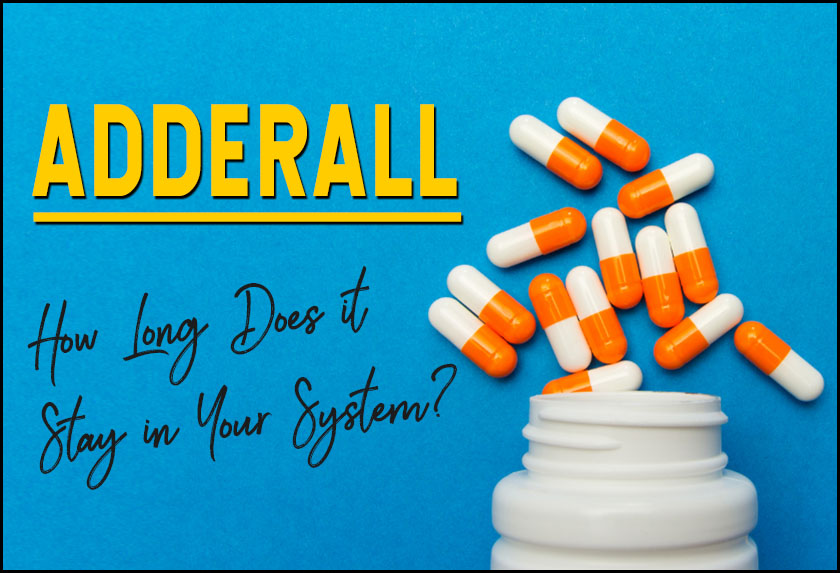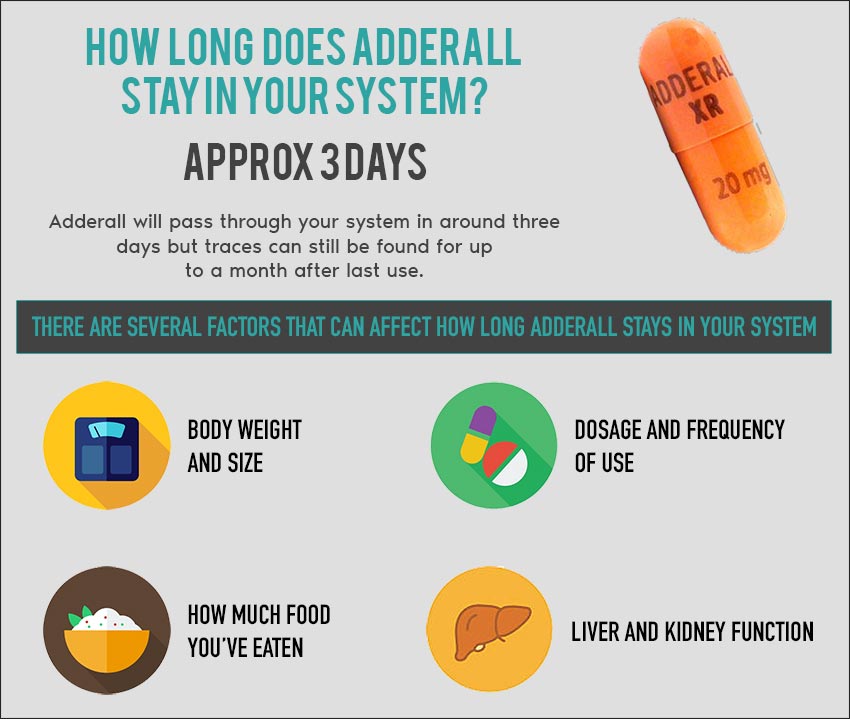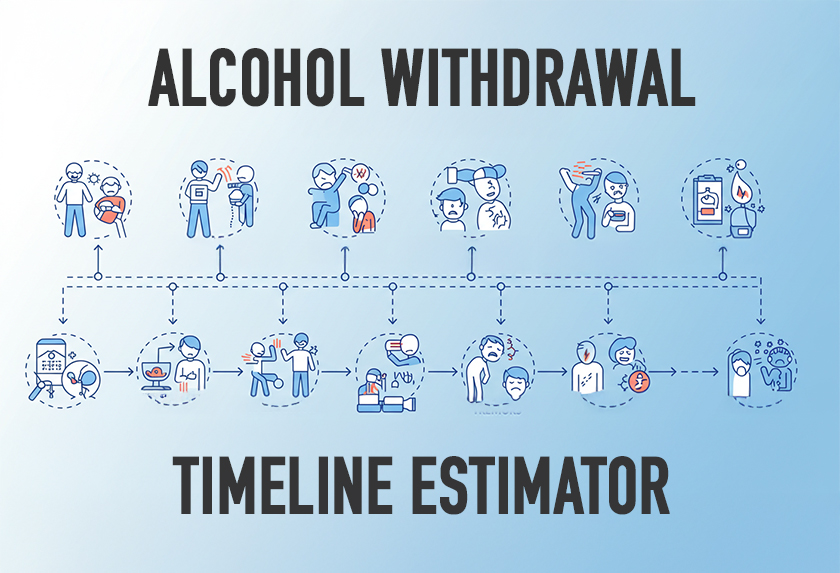How long does Adderall stay in your system?
Adderall stays in your system for approximately three days but traces of it can be found for up to a month after last use.
That’s the quick answer. Let’s dig deeper.
Adderall
Adderall is a stimulant that contains a combination of amphetamine and dextroamphetamine. The medication is commonly prescribed to children and adults to relieve the symptoms of Attention Deficit Hyperactivity Disorder and Narcolepsy. According to a study published in the Journal of Pediatric Pharmacology and Therapeutics, the stimulant helps relieve the symptoms of up to 80% of children suffering from ADHD.
Adderall is available in two forms: Adderall IR (immediate-release) and Adderall XR (extended-release)—and as you can guess from the brand names, each variation has a different release timeline in your body. So, how long does Adderall last XR last? Adderall XR is released slowly throughout the day and may last for up to 10 hours in your system.
Despite its notable therapeutic benefits, the prescription has a high risk of abuse and misuse. It’s especially popular among college students who assume that the stimulants will improve their cognitive abilities. But contrary to this popular belief, research shows that the impact of Adderall in neurocognitive performance is negligible.
Read on to find out the Adderall half-life, how it works, how long Adderall lasts in your body, the risk of misuse, treatment for Adderall addiction, and everything in-between.
Here’s How Adderall Works
People with ADHD lack enough dopamine—a neurotransmitter involved in attention, motivation, and reward. For this reason, they tend to engage in ‘thrill-seeking’ experiences while finding it hard to focus.
When consumed to help remedy the symptoms of ADHD, Adderall stimulates the CNS (central nervous system). It increases the availability of dopamine in the brain’s ‘reward center’ – i.e., the frontal lobe. Please note that Adderall medication is just one facet of a comprehensives ADHD treatment program
Adderall Half-Life
Before highlighting how long it lasts in your body, it important to understand the Adderall half-life. According to the Food and Drug Administration (FDA), Adderall’s half-life is anywhere between 9-14 hours. This means that the body metabolizes half of the Adderall you take after 14 hours, another half after that, and so on.
As a general rule of thumb, drugs typically take 5.5 half-lives to completely leave the body. With this in mind, it may take up to 3 days for the drug to completely clear your system – i.e., 5.5 x 14 = 72 hours (roughly 3 days).
In summary, Adderall will pass through your system in around three days—but as we’ll highlight later in the article, traces can still be found for up to a month after last use. For this reason, the answer to the question; “how long does Adderall stay in your system?” is not as straightforward as you may assume. It depends on several factors
What Factors Can Affect How Long Adderall Stays in Your System?
There are several factors that can affect how long Adderall stays in your system.
- Body weight and size – If your body is high in fat and low in muscle tone, Adderall will pass through your system relatively quickly. Adderall is constructed from substances which are hydrophilic. This means they mix well with water and people who have high muscle tone have more water coursing through their bodies. Therefore, the Adderall has more space and volume to circulate around in.
- How much food you’ve eaten – If you’ve taken Adderall on an empty stomach, it may pass through your system quicker. This is because your body will work to metabolize any food in your system at that same time as it works to metabolize the Adderall. This means that both the food and the Adderall will take longer to completely leave your body.
- Dosage and frequency of use– The higher the dose you take, the longer it will take to be eliminated from your body. In the same way, if you’re using a lot of Adderall, it will build up in your system, and again, take longer to leave your body.
- Liver and Kidney function – The liver and kidneys play a huge part in metabolizing substances so if either one of these—or both—is not working properly, elimination from the body will take longer.
How Is an Adderall Drug Test Taken?
There are four main ways to test for Adderall use—with each having different detection timeframes as shown below:
- Urine Test – How long does Adderall stay in your urine? Traces of Adderall can show up in your urine for up to three days after use. However, it is easier to detect in urine samples up to 18 hours after use.
- Hair Test– Adderall can be found in a hair sample for up to a month after use. However, it may not show up until one week after
- Saliva Test – Saliva testing is not often used to detect Adderall, but a saliva swab can provide a positive result after only 20 minutes of last use. It remains in saliva for up to 48 hours.
- Blood Test – Blood testing is also rare due to it being an invasive procedure and Adderall can only be detected up to 24 hours of last use.
Side Effects, Misuse, and Abuse
According to the Controlled Substance Act (CSA) Scheduling, Adderall is classified as a Schedule II drug—meaning it has “a high potential for abuse, with use potentially leading to severe psychological or physical dependence.” For this reason, its prescription is highly regulated.
Despite the dangers posed by the drug, it’s still widely abused—especially in colleges. A study appearing in the Clinical Child and Family Psychology Review points out that around 17% of students in college campuses misused Adderall and other stimulants to stay up for longer and improve their focus. Similarly, SAMHSA (Substances Abuse and Mental Health Services Administration) notes that the rate of Adderall misuse increased by roughly 100,000 between 2016 and 2017.
Abusing Adderall can lead to mild-dangerous side effects such as:
- Headache
- Trouble breathing
- Digestive problems
- Dry mouth
- Restlessness
- Aggressive behavior
- Pounding or fast heartbeat
- Dizziness
- Numbness in the arms or legs
- Difficulty sleeping
- Reduced appetite Hyperventilation
- Seizures
- Mania
- Changes in sex drive
- Paranoia
Is Adderall Addictive?
When used recreationally, Adderall is highly addictive and like most drugs—as time goes on—higher doses are needed to recreate the original high. Some tell-a-tale signs of Adderall addiction include:
- A craving for the drug.
- Difficulty reducing the amount consumed.
- An inability to meet home, school, and work-related responsibilities.
- Using the drug in life-threatening situations.
- Interpersonal and social problems.
- Continued use despite psychological and physical problems caused by the drug.
- Tolerance—evidenced by an increasing ‘appetite’.
- Spending a considerable amount of resources to acquire and recover from Adderall.
When a person who is addicted to Adderall attempts to cut down on usage, he or she may experience withdrawal symptoms, including:
- Increased appetite.
- Insomnia or sleeping more than normal.
- Slowed movements.
- Slowed heart rate.
- Vivid dreams.
- Lack of pleasure.
Risk of Combining Adderall with Other Substances
As highlighted above, Adderall poses several health risks on its own. When combined with other substances such as alcohol, Xanax, or marijuana, its harmful effects can be unpredictable and even more dangerous.
Regarding the interaction of Adderall and alcohol, the amphetamine in Adderall is a stimulant that covers/delays the usual signs of intoxication—including the lack of coordination and drowsiness. For this reason, you may not realize that you are in fact drunk. This increases the risk of consuming alcohol to a dangerous level which can result in accidents, serious illnesses, or alcohol poisoning. The same increased health risk applies to other substances such as Xanax or marijuana.
Getting Help for Adderall Addiction
Back to the main question: How long does Adderall last? As highlighted Adderall half-life is 9-14 hours—but the time it takes to leave the body depends on several factors such as body mass index, food consumed, dosages, frequency, and the functioning of relevant body systems. Moreover, different drug tests detect the presence of Adderall in your system at different time frames.
If you’re concerned about your Adderall use, or a loved one’s use, seeking advice from a medical professional or treatment facility is the first step to recovery. Revive Recovery & Detox offers a wide range of treatment programs—including detox services, medication-assisted treatment, evidence-based, and holistic-based therapies—to facilitate a safe recovery journey.














